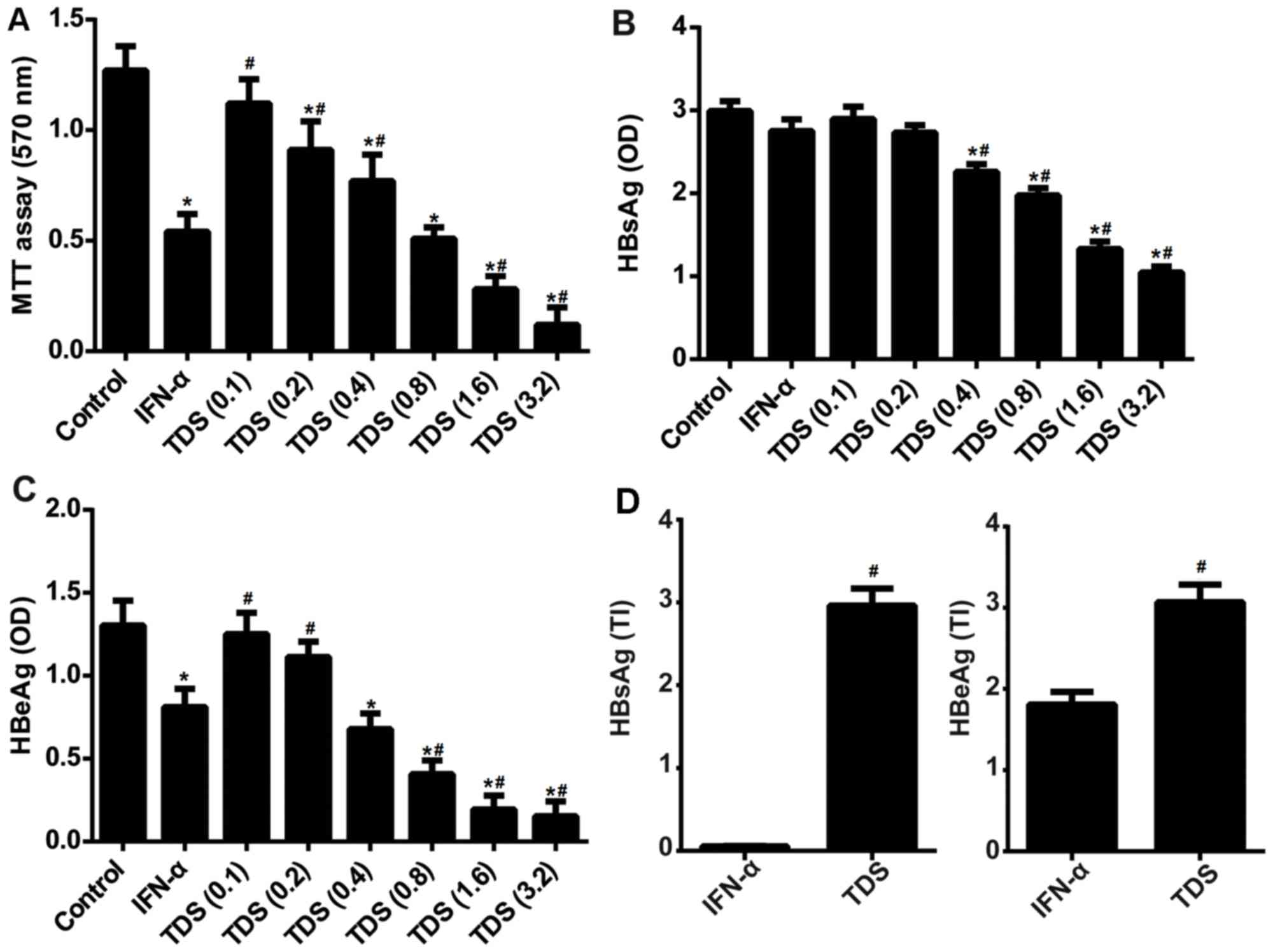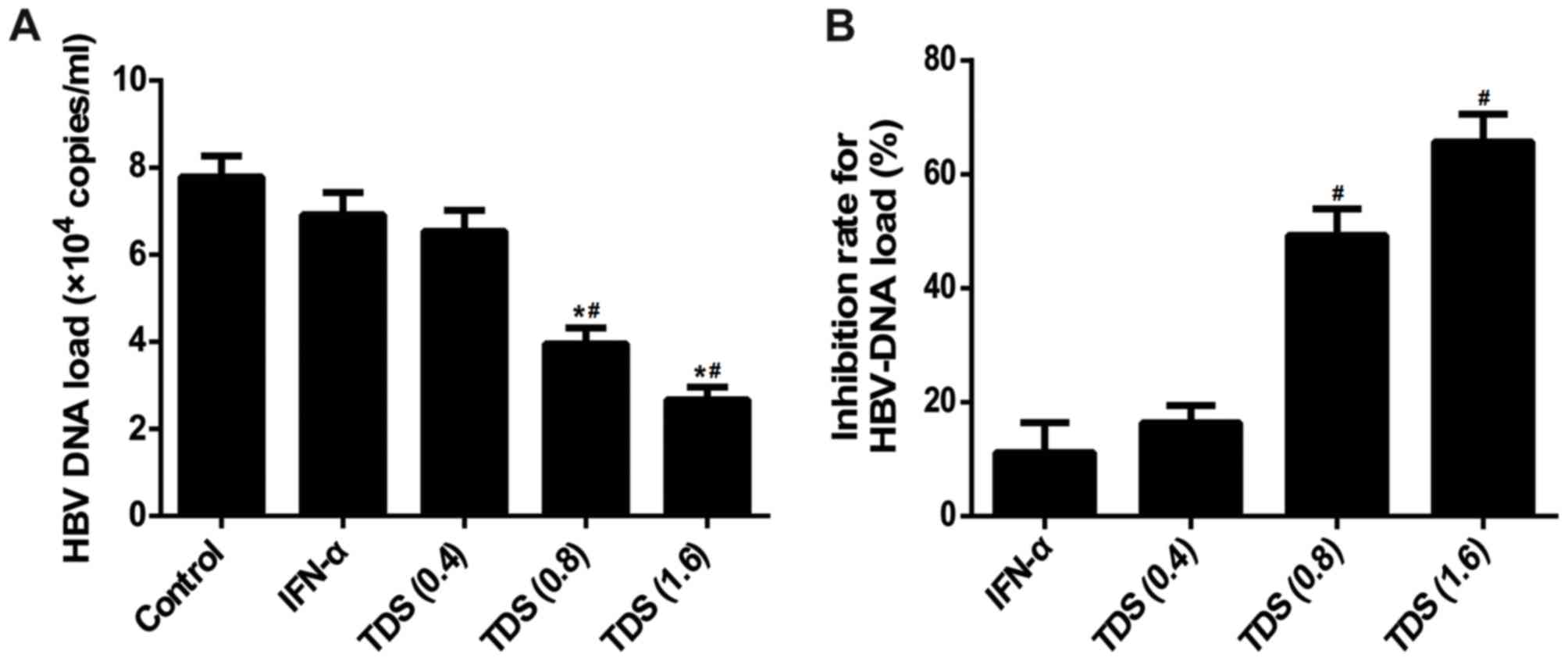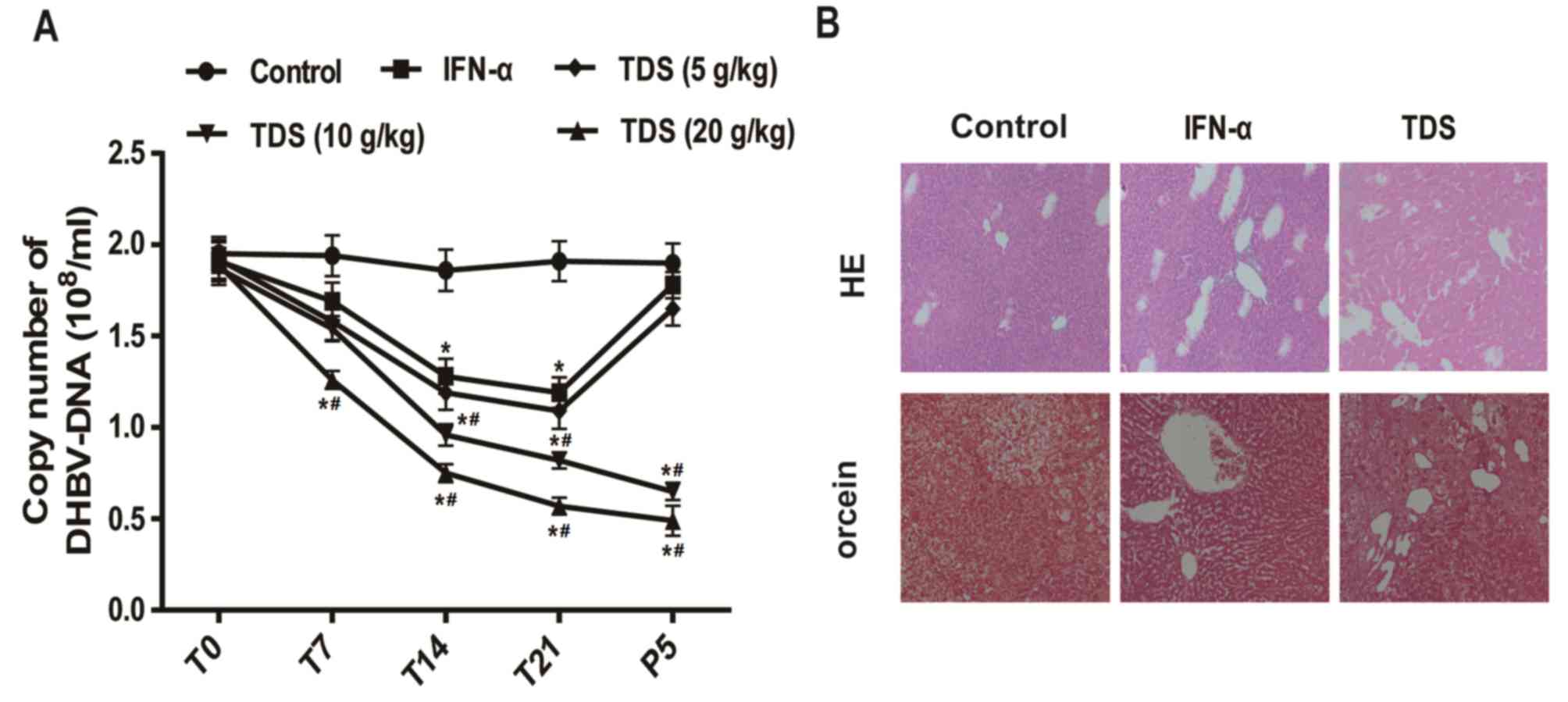|
1
|
Seeger C and Mason WS: Hepatitis B virus
biology. Microbiol Mol Biol Rev. 64:51–68. 2000. View Article : Google Scholar : PubMed/NCBI
|
|
2
|
Choi JG, Chung YH, Kim JA, Jin YJ, Park
WH, Lee D, Shim JH, Lee YS, Seo DD, Jang MK, et al: High HBV-DNA
titer in surrounding liver rather than in hepatocellular carcinoma
tissue predisposes to recurrence after curative surgical resection.
J Clin Gastroenterol. 46:413–419. 2012. View Article : Google Scholar : PubMed/NCBI
|
|
3
|
Yang G, Han M, Chen F, Xu Y, Chen E, Wang
X, Liu Y, Sun J, Hou J, Ning Q and Wang Z: Hepatitis B virus
genotype B and mutations in basal core promoter and pre-core/core
genes associated with acute-on-chronic liver failure: A multicenter
cross-sectional study in China. Hepatol Int. 8:508–516. 2014.
View Article : Google Scholar : PubMed/NCBI
|
|
4
|
Mangano C, Squadrito G, Cacciola I,
Carpentieri M, Foti G and Raimondo G: Effectiveness of add-on
pegylated interferon alfa-2a therapy in a lamivudine-treated
patient with chronic hepatitis B. Ann Hepatol. 10:84–87.
2011.PubMed/NCBI
|
|
5
|
Cho H and Kelsall BL: The role of type I
interferons in intestinal infection, homeostasis, and inflammation.
Immunol Rev. 260:145–167. 2014. View Article : Google Scholar : PubMed/NCBI
|
|
6
|
Bandurska K, Król I and Myga-Nowak M:
Interferons: Between structure and function. Postepy Hig Med Dosw
(Online). 68:428–440. 2014.(In Polish). View Article : Google Scholar : PubMed/NCBI
|
|
7
|
Pestka S, Krause CD and Walter MR:
Interferons, interferon-like cytokines, and their receptors.
Immunol Rev. 202:8–32. 2004. View Article : Google Scholar : PubMed/NCBI
|
|
8
|
Horras CJ, Lamb CL and Mitchell KA:
Regulation of hepatocyte fate by interferon-γ. Cytokine Growth
Factor Rev. 22:35–43. 2011. View Article : Google Scholar : PubMed/NCBI
|
|
9
|
Gao B, Wang H, Lafdil F and Feng D: STAT
proteins-key regulators of anti-viral responses, inflammation, and
tumorigenesis in the liver. J Hepatol. 57:430–441. 2012. View Article : Google Scholar : PubMed/NCBI
|
|
10
|
Koumbi L: Current and future antiviral
drug therapies of hepatitis B chronic infection. World J Hepatol.
7:1030–1040. 2015. View Article : Google Scholar : PubMed/NCBI
|
|
11
|
Geng D, Wang Y, Wang P, Li W and Sun Y:
Stable expression of hepatitis B surface antigen gene in Dunaliella
salina (Chlorophyta). J Appl Phycol. 15:451–456. 2003. View Article : Google Scholar
|
|
12
|
Sun Y, Yang Z, Gao X, Li Q, Zhang Q and Xu
Z: Expression of foreign genes in Dunaliella by electroporation.
Mol Biotechnol. 30:185–192. 2005. View Article : Google Scholar : PubMed/NCBI
|
|
13
|
Feng S, Li X, Xu Z and Qi J: Dunaliella
salina as a novel host for the production of recombinant proteins.
Appl Microbiol Biotechnol. 98:4293–4300. 2014. View Article : Google Scholar : PubMed/NCBI
|
|
14
|
Wang HH, Yin WB and Hu ZM: Advances in
chloroplast engineering. J Genet Genomics. 36:387–398. 2009.
View Article : Google Scholar : PubMed/NCBI
|
|
15
|
Barzegari A, Hejazi MA, Hosseinzadeh N,
Eslami S, Mehdizadeh Aghdam E and Hejazi MS: Dunaliella as an
attractive candidate for molecular farming. Mol Biol Rep.
37:3427–3430. 2010. View Article : Google Scholar : PubMed/NCBI
|
|
16
|
Sells MA, Chen ML and Acs G: Production of
hepatitis B virus particles in Hep G2 cells transfected with cloned
hepatitis B virus DNA. Proc Natl Acad Sci USA. 84:1005–1009. 1987.
View Article : Google Scholar : PubMed/NCBI
|
|
17
|
Zhu X, Xie C, Li YM, Huang ZL, Zhao QY, Hu
ZX, Wang PP, Gu YR, Gao ZL and Peng L: TMEM2 inhibits hepatitis B
virus infection in HepG2 and HepG2.2.15 cells by activating the
JAK-STAT signaling pathway. Cell Death Dis. 7:e22392016. View Article : Google Scholar : PubMed/NCBI
|
|
18
|
Li L, Lei QS, Zhang SJ, Kong LN and Qin B:
Suppression of USP18 potentiates the anti-HBV activity of
interferon alpha in HepG2.2.15 cells via JAK/STAT signaling. PLoS
One. 11:e01564962016. View Article : Google Scholar : PubMed/NCBI
|
|
19
|
Romani L, Bistoni F, Montagnoli C, Gaziano
R, Bozza S, Bonifazi P, Zelante T, Moretti S, Rasi G, Garaci E and
Puccetti P: Thymosin alpha1: An endogenous regulator of
inflammation, immunity, and tolerance. Ann N Y Acad Sci.
1112:326–338. 2007. View Article : Google Scholar : PubMed/NCBI
|
|
20
|
Billich A: Thymosin alpha1. SciClone
Pharmaceuticals. Curr Opin Invest Drugs. 3:698–707. 2002.
|
|
21
|
Feng SY, Xue LX, Liu HT and Lu PJ:
Improvement of efficiency of genetic transformation for Dunaliella
salina by glass beads method. Mol Biol Rep. 36:1433–1439. 2009.
View Article : Google Scholar : PubMed/NCBI
|
|
22
|
Meng XP, Yang JY, Qiao XL, Liang LX and
Shou-Min XI: Optimization of construction of fusion gene-BTRCP-CypA
by using SOE-PCR technique. Biotechnology. 23:51–54. 2013.
|
|
23
|
Pant K, Gupta P, Damania P, Yadav AK,
Gupta A, Ashraf A and Venugopal SK: Mineral pitch induces apoptosis
and inhibits proliferation via modulating reactive oxygen species
in hepatic cancer cells. BMC Complement Altern Med. 16:1482016.
View Article : Google Scholar : PubMed/NCBI
|
|
24
|
Mi S: A research for screening
anti-hepatitis B virus drugs with the 2.2.15 cell line. Zhonghua Yi
Xue Za Zhi. 72:612–615, 640. 1992.(In Chinese). PubMed/NCBI
|
|
25
|
Livak KJ and Schmittgen TD: Analysis of
relative gene expression data using real-time quantitative PCR and
the 2(-Delta Delta C(T)) method. Methods. 25:402–408. 2001.
View Article : Google Scholar : PubMed/NCBI
|
|
26
|
Sari M: Effects of production system and
gender on liveweight and body measurements in pekin ducks. Atatürk
Üniversitesi Vet Bil Derg. 8:112–121. 2013.
|
|
27
|
Low HC: Molecular analysis of acute and
chronic duck hepatitis B virus (DHBV) infections in ducks.
(unpublished PhD thesis). University of Adelaide, School of
Molecular and Biomedical Science; Adelaide, South Australia;
2012
|
|
28
|
Tian Y, Chen WL and Ou JH: Effects of
interferon-α/β on HBV replication determined by viral load. PLoS
Pathog. 7:e10021592011. View Article : Google Scholar : PubMed/NCBI
|
|
29
|
Guidotti LG, Morris A, Mendez H, Koch R,
Silverman RH, Williams BR and Chisari FV: Interferon-regulated
pathways that control hepatitis B virus replication in transgenic
mice. J Virol. 76:2617–2621. 2002. View Article : Google Scholar : PubMed/NCBI
|
|
30
|
Hansen BE, Buster EH, Steyerberg EW,
Lesaffre E and Janssen HL: Prediction of the response to
peg-interferon-alfa in patients with HBeAg positive chronic
hepatitis B using decline of HBV DNA during treatment. J Med Virol.
82:1135–1142. 2010. View Article : Google Scholar : PubMed/NCBI
|
|
31
|
Lu NF, Huang AL, Zheng RQ, Zhu YB, Xia ZF,
Tang N, Yan G, Gao XL and Wu Y: Anti-HBV effect of fusion protein
(TA1-IFN) in vitro. Zhonghua Gan Zang Bing Za Zhi. 13:252–254.
2005.(In Chinese). PubMed/NCBI
|
|
32
|
Cho HJ, Kim JK, Nam JS, Wang HJ, Lee JH,
Kim BW, Kim SS, Noh CK, Shin SJ, Lee KM, et al: High circulating
microRNA-122 expression is a poor prognostic marker in patients
with hepatitis B virus-related hepatocellular carcinoma who undergo
radiofrequency ablation. Clin Biochem. 48:1073–1078. 2015.
View Article : Google Scholar : PubMed/NCBI
|
|
33
|
Ganem D and Prince AM: Hepatitis B virus
infection-natural history and clinical consequences. N Engl J Med.
350:1118–1129. 2004. View Article : Google Scholar : PubMed/NCBI
|
|
34
|
Rehermann B and Nascimbeni M: Immunology
of hepatitis B virus and hepatitis C virus infection. Nat Rev
Immunol. 5:215–229. 2005. View
Article : Google Scholar : PubMed/NCBI
|
|
35
|
Xu WS, Zhao KK, Miao XH, Ni W, Cai X,
Zhang RQ and Wang JX: Effect of oxymatrine on the replication cycle
of hepatitis B virus in vitro. World J Gastroenterol. 16:2028–2037.
2010. View Article : Google Scholar : PubMed/NCBI
|
|
36
|
Mason WS, Seal G and Summers J: Virus of
Pekin ducks with structural and biological relatedness to human
hepatitis B virus. J Virol. 36:829–836. 1980.PubMed/NCBI
|
|
37
|
Liu Q, Jia R, Wang M, Huang J, Zhu D, Chen
S, Yin Z, Wang Y, Chen X and Cheng A: Cloning, expression and
purification of duck hepatitis B virus (DHBV) core protein and its
use in the development of an indirect ELISA for serologic detection
of DHBV infection. Arch Virol. 159:897–904. 2014. View Article : Google Scholar : PubMed/NCBI
|













